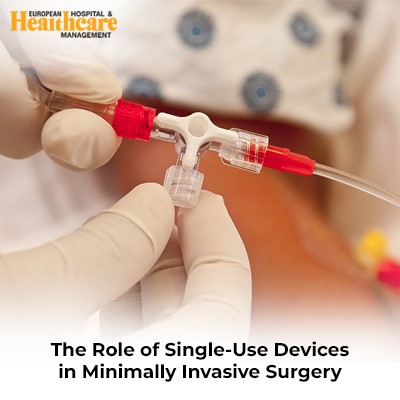Single-use devices (SUDs) revolutionize minimally invasive surgery (MIS) by enhancing precision, reducing infection risks, and streamlining workflows. Despite environmental and cost challenges, SUDs offer significant long-term benefits. Future advancements in materials, technology, and sustainability will further solidify their role in improving surgical outcomes and patient care in MIS.

Minimally invasive surgery (MIS) has revolutionized the field of surgery, providing numerous benefits over traditional open surgery, including reduced pain, shorter hospital stays, faster recovery times, and minimized scarring. One of the key advancements enabling MIS is the development and use of single-use devices (SUDs). These devices have gained prominence due to their unique advantages in enhancing surgical outcomes, ensuring patient safety, and streamlining procedural efficiency. This article explores the role of single-use devices in minimally invasive surgery, examining their benefits, challenges, and future prospects.
Infection Control and Patient Safety
Single-use devices are designed to be used on a single patient and then discarded, which significantly reduces the risk of cross-contamination and infection. Traditional reusable devices require rigorous sterilization processes that, if not properly executed, can leave residual pathogens. SUDs eliminate this risk, ensuring a sterile and safe surgical environment. This is particularly crucial in MIS, where the use of smaller incisions and advanced instruments demands a high level of sterility to prevent postoperative infections.
Cost-Effectiveness
While the initial cost of single-use devices may be higher compared to reusable counterparts, they often prove to be cost-effective in the long run. The elimination of sterilization costs, reduced need for maintenance, and lower risk of infection-related complications contribute to overall cost savings. Additionally, the predictability of SUDs' performance can lead to more efficient surgeries, reducing operative time and associated expenses.
Enhanced Precision and Performance
Single-use devices are typically designed with advanced materials and technology, providing superior performance and precision. They are engineered to meet specific surgical requirements, offering consistency and reliability in their function. This is particularly beneficial in MIS, where precision is paramount due to the delicate nature of the procedures and the limited visibility and access within the surgical field.
Streamlined Workflow
The use of SUDs can streamline the surgical workflow by eliminating the need for device reprocessing and sterilization between procedures. This allows for quicker turnover times in operating rooms, improving overall efficiency and throughput. In high-volume surgical centers, this can lead to significant improvements in patient care and resource utilization.
Environmental Impact
One of the primary challenges associated with single-use devices is their environmental impact. The disposal of SUDs generates medical waste, which can contribute to environmental pollution. The healthcare industry is increasingly focused on sustainability, and the use of disposable devices poses a challenge to these efforts. Developing biodegradable materials and implementing recycling programs are potential solutions to mitigate this issue.
Cost Considerations
Although SUDs can be cost-effective in the long term, the initial expenditure for purchasing these devices can be a barrier for some healthcare facilities, particularly in resource-limited settings. Balancing the upfront costs with the potential savings from reduced infection rates and improved surgical efficiency requires careful financial planning and justification.
Limited Availability of Specialized Devices
In some specialized fields of MIS, the availability of single-use devices may be limited. Customization and innovation in SUDs are necessary to cater to the specific needs of various surgical disciplines. Continued research and development are essential to expand the range of single-use devices and ensure their applicability across different types of minimally invasive surgeries.
Technological Advancements
The future of single-use devices in MIS is closely tied to technological advancements. Innovations in materials science, microfabrication, and nanotechnology are expected to lead to the development of more sophisticated and versatile SUDs. These advancements will enhance the performance, safety, and cost-effectiveness of single-use devices, making them even more integral to minimally invasive surgical procedures.
Personalized Medicine and Customization
As personalized medicine continues to evolve, the customization of single-use devices to meet individual patient needs will become increasingly important. Tailoring devices to specific anatomical and pathological conditions can improve surgical outcomes and reduce complications. 3D printing technology, for example, holds great promise in creating patient-specific single-use instruments and implants.
Integration with Digital and Robotic Systems
The integration of single-use devices with digital and robotic surgical systems represents a significant future trend. Combining the precision of robotic surgery with the reliability of SUDs can further enhance the capabilities of minimally invasive procedures. This integration can lead to more precise and controlled surgeries, minimizing human error and improving patient outcomes.
Sustainability Initiatives
Addressing the environmental impact of single-use devices will be a critical focus moving forward. Developing biodegradable or recyclable materials for SUDs can help reduce medical waste and promote sustainability in healthcare. Additionally, implementing comprehensive recycling programs within healthcare facilities can further mitigate the environmental footprint of disposable devices.
Single-use devices play a pivotal role in minimally invasive surgery, offering numerous benefits that enhance patient safety, surgical precision, and procedural efficiency. While challenges such as environmental impact and initial costs exist, ongoing technological advancements and sustainability initiatives are poised to address these issues. As the field of MIS continues to evolve, single-use devices will remain integral to the advancement of surgical techniques, ultimately improving patient care and outcomes. Embracing innovation and sustainability will be key to maximizing the potential of single-use devices in the future of minimally invasive surgery.